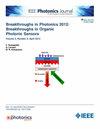基于学习数字反向传播的偏振模色散并行分布补偿
IF 2.4
4区 工程技术
Q3 ENGINEERING, ELECTRICAL & ELECTRONIC
引用次数: 0
摘要
提出了一种学习数字反向传播(LDBP)算法,该算法对偏振模色散(PMD)进行并行的分布式补偿。提出的LDBP算法利用光纤非线性Schrödinger方程的正则摄动理论来创建具有完全并行化能力的深度神经网络(DNN)。通过在1000公里标准单模光纤链路上的数值实验,对该算法的非线性补偿性能进行了评价。该链路采用密集波分复用(DWDM)系统,具有5个波长通道,64-QAM调制,每个通道的符号速率为32 GBaud/s。实验结果表明,即使对于具有相同光功率的低复杂度网络训练,该方法也能比集总补偿方法提供约0.4 dB的性能提升。这表明并行化虽然提高了NLC的执行效率,但并没有降低该方法相对于集总补偿方法的优势。最后,研究了并行化对计算效率的提高。结果表明,与串行执行相比,并行执行的计算效率提高了约67倍。本文的研究结果为实现NLC提供了一种可行的解决方案,在实践中可以显著提高硬件效率。本文章由计算机程序翻译,如有差异,请以英文原文为准。
Distributed Compensation With Parallelizability for Polarization Mode Dispersion Based on Learned Digital Backpropagation
This study proposes a learned digital backward propagation (LDBP) algorithm that performs a distributed compensation of polarization mode dispersion (PMD) in parallel. The proposed LDBP algorithm uses the regular perturbation theory of a fiber-optic nonlinear Schrödinger equation to create a deep neural network (DNN) with full parallelization capabilities. The proposed algorithm’s nonlinear compensation (NLC) performance is evaluated using numerical experiments on a 1,000-kilometer standard single-mode fiber link. The link uses a dense wavelength division multiplexing (DWDM) system with five wavelength channels, 64-QAM modulation, and a symbol rate of 32 GBaud/s per channel. The experimental results demonstrate that, even for low-complexity network training with identical optical power, the proposed method can provide a performance improvement of approximately 0.4 dB over lumped compensation methods. This indicates that parallelization, which improves the efficiency of NLC execution, does not reduce the proposed method’s advantage over lumped compensation methods. Finally, the improvement of the computational efficiency caused by parallelization is investigated. The results show that parallelization improves computational efficiency by about 67 times compared to serial execution. The findings of this paper provide a feasible solution for implementing NLC, which can significantly improve hardware efficiency in practice.
求助全文
通过发布文献求助,成功后即可免费获取论文全文。
去求助
来源期刊

IEEE Photonics Journal
ENGINEERING, ELECTRICAL & ELECTRONIC-OPTICS
CiteScore
4.50
自引率
8.30%
发文量
489
审稿时长
1.4 months
期刊介绍:
Breakthroughs in the generation of light and in its control and utilization have given rise to the field of Photonics, a rapidly expanding area of science and technology with major technological and economic impact. Photonics integrates quantum electronics and optics to accelerate progress in the generation of novel photon sources and in their utilization in emerging applications at the micro and nano scales spanning from the far-infrared/THz to the x-ray region of the electromagnetic spectrum. IEEE Photonics Journal is an online-only journal dedicated to the rapid disclosure of top-quality peer-reviewed research at the forefront of all areas of photonics. Contributions addressing issues ranging from fundamental understanding to emerging technologies and applications are within the scope of the Journal. The Journal includes topics in: Photon sources from far infrared to X-rays, Photonics materials and engineered photonic structures, Integrated optics and optoelectronic, Ultrafast, attosecond, high field and short wavelength photonics, Biophotonics, including DNA photonics, Nanophotonics, Magnetophotonics, Fundamentals of light propagation and interaction; nonlinear effects, Optical data storage, Fiber optics and optical communications devices, systems, and technologies, Micro Opto Electro Mechanical Systems (MOEMS), Microwave photonics, Optical Sensors.
 求助内容:
求助内容: 应助结果提醒方式:
应助结果提醒方式:


